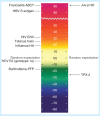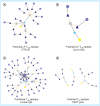Time for T? Immunoinformatics addresses vaccine design for neglected tropical and emerging infectious diseases
- PMID: 25193104
- PMCID: PMC4743591
- DOI: 10.1586/14760584.2015.955478
Time for T? Immunoinformatics addresses vaccine design for neglected tropical and emerging infectious diseases
Abstract
Vaccines have been invaluable for global health, saving lives and reducing healthcare costs, while also raising the quality of human life. However, newly emerging infectious diseases (EID) and more well-established tropical disease pathogens present complex challenges to vaccine developers; in particular, neglected tropical diseases, which are most prevalent among the world's poorest, include many pathogens with large sizes, multistage life cycles and a variety of nonhuman vectors. EID such as MERS-CoV and H7N9 are highly pathogenic for humans. For many of these pathogens, while their genomes are available, immune correlates of protection are currently unknown. These complexities make developing vaccines for EID and neglected tropical diseases all the more difficult. In this review, we describe the implementation of an immunoinformatics-driven approach to systematically search for key determinants of immunity in newly available genome sequence data and design vaccines. This approach holds promise for the development of 21st century vaccines, improving human health everywhere.
Keywords: Brugia malayi; EID; EpiMatrix; JanusMatrix; MHC; NTD; T cell; TCR; computational vaccinology; filarial; immunogenicity; immunoinformatics; immunomics; tregitope.
Figures





References
-
- Centers for Disease Control and Prevention (CDC) Chikungunya fever diagnosed among international travelers–United States, 2005-2006. MMWR Morb Mortal Wkly Rep 55(38):1040-2 - PubMed
-
- Arce A, Estirado A, Ordobas M, et al. . Re-emergence of leishmaniasis in Spain: community outbreak in Madrid, Spain, 2009 to 2012. Euro Surveill 2013;18(30):20546. - PubMed
Publication types
MeSH terms
Substances
Grants and funding
LinkOut - more resources
Full Text Sources
Other Literature Sources
Medical
Research Materials
